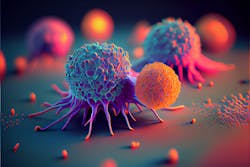A new pathologic scoring system that accurately assesses how much lung tumor is left after a patient receives presurgical cancer treatments can be used to predict survival, according to new research led by investigators at the Bloomberg~Kimmel Institute for Cancer Immunotherapy at the Johns Hopkins Kimmel Cancer Center and the Mark Foundation Center for Advanced Genomics and Imaging at the Johns Hopkins University.
The study shows that pathologic assessment of residual viable tumor (RVT) in patients treated with immunotherapy and chemotherapy before lung cancer surgery provides a robust and efficient evaluation of patient treatment response that may be useful to guide patient therapy and predict survival. This latter finding supports pathologic evaluation of tumors as an early clinical trial endpoint and a surrogate of survival for potential accelerated regulatory approvals.
The results were published on Nov. 4 in the journal Nature Medicine and simultaneously presented by senior study author Janis Taube, M.D., M.Sc., director of the Division of Dermatopathology at the Johns Hopkins University School of Medicine and a member of the Kimmel Cancer Center, at the Society for Immunotherapy of Cancer annual meeting in San Diego.
For the new study, investigators performed a new analysis on data from the randomized, phase 3 CheckMate 816 study. That study found that treating presurgical non-small cell lung cancer patients with immunotherapy (nivolumab) plus chemotherapy improved event-free survival. This important surrogate endpoint can help predict long-term survival and pathologic complete response, which measures whether any tumor is left.
During the study, the investigators used a new approach, which measures residual tumor in patients who received neoadjuvant therapy, to predict outcomes in patients with a greater range of treatment responses. They used immune-related pathologic response criteria (irPRC) to look for pathologic changes that indicated the tumor had been present in the tissue before immunotherapy but was destroyed by the treatment, allowing them to measure what percentage of the tumor was left, or the RVT, ranging from 0% to 100%.
As a result, they were able to separate patients into three groups based on how much tumor was left. In the future, data such as these may help guide the next round of clinical trials and ultimately help oncologists decide how to treat individuals in these subgroups, Deutsch says. For example, patients with no tumor left may be able to skip postsurgical immunotherapy or have a relatively limited amount, while individuals in the intermediate group may need to continue immunotherapy for longer. Those who showed a very limited response may need to switch to a new therapy or add a new therapy to their regimen. The team’s next steps will include identifying the most clinically meaningful cutoffs for RVT.
They also looked beyond the primary tumor and used RVT to assess the immunotherapy effect on tumor in the lymph nodes, which showed additive value with the primary tumor for predicting survival. Long term, it may also be possible to strategically combine pathology, radiology and ctDNA results for the longitudinal monitoring of treatment efficacy.
Already, the investigators demonstrated the pathologic scoring system can assess 10 types of tumors, including lung, skin and colorectal cancers, which could be another advantage over other tumor scoring systems.

